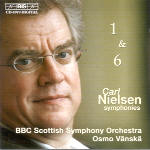Osmo Vänskä is a fine conductor who always brings fresh ideas to the music he performs. Sometimes they work, and sometimes they don’t. Here they don’t, or at least not always. In general Vänskä secures committed playing from the BBC Scottish Symphony despite moments of less-than-stellar tone from the woodwinds (third movement of the First Symphony) and occasionally undernourished violins (first movement of the Sixth). What problems these performances have all involve tempo and fall into two basic categories: an exaggerated contrast between fast and slow within a movement, and a basic tempo that isn’t optimal to begin with.
In the first category, consider the outer movements of the First Symphony. This lively, youthful effort has all of Nielsen’s characteristic energy and harmonic style, but it lacks the organic flow of his later efforts and needs some help from the conductor in order to sustain its musical momentum. The first movement opens with impressive thrust but almost immediately loses energy with the entrance of the second subject–and by the end of the exposition all movement has come to a standstill. In the finale we witness the same problem despite the fact that Nielsen’s only modification of the basic tempo is “Poco tranquillo”, and we know that this refers to character and expression more than tempo because he sees no need to reestablish Tempo 1 (Allegro con fuoco) at the recapitulation, which here lurches forward most awkwardly as a result of a much-too-slow approach. The second movement comes off best, its slow basic tempo well sustained.
In the second category, movements with less than optimal overall tempos, are the excessively leisurely third movement of the First Symphony, the first movement of the Sixth Symphony, and its “Proposta seria” Adagio, which really drags. Vänskä’s Sibelius performances also offer some daringly distended slow movements (in the Third and Fourth Symphonies particularly), but Nielsen’s music needs more muscle and a stronger directional focus; it relies far less on atmosphere and musical pattern-making. And so Vänskä takes the second movement Humoreske a bit too quickly for its strangeness to fully manifest itself. The same holds true of the finale, with its wacky waltz variation distressingly underplayed (Where is the rhythm in the bass drum?) and the hilarious coda disappointingly matter-of-fact (though the final variation featuring solo xylophone and tuba gets the full treatment).
Finally, there is that trademark Vänskä mannerism, the obligatory super-pianissimo. In the First Symphony it occurs at the beginning of the first movement’s coda, and in the Sixth just after the warm, augmented pastoral presentation of the first movement’s opening theme when strings, flute, and glockenspiel engage in a mincing little dialog. Neither passage benefits by such treatment, and Vänskä really ought to reserve this tactic for the places where the composer calls for it. In the final analysis, and despite climaxes in both symphonies that are impressively articulated and very excitingly played, it sounds as though neither conductor nor orchestra has internalized this music in the way that, say, Michael Schonwandt and his Danish players have in their recent superb Nielsen cycle for Da Capo, which incidentally features this identical coupling. Good sonics, but ultimately these performances just aren’t competitive with the best.
































